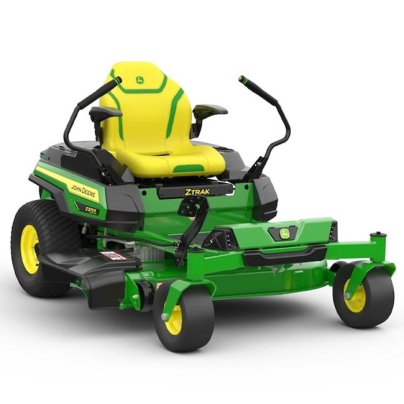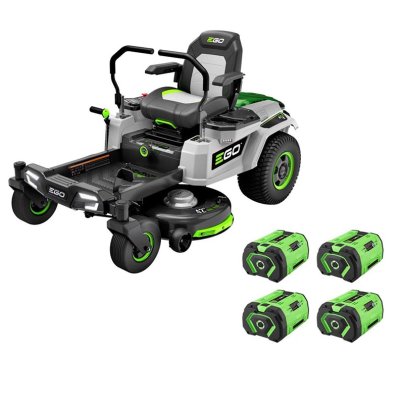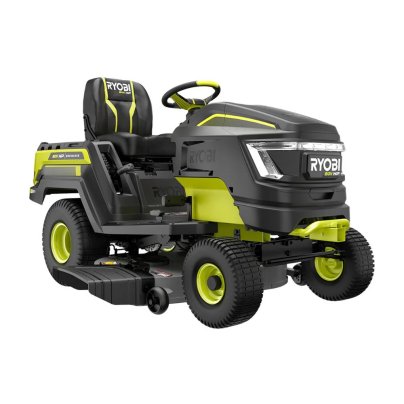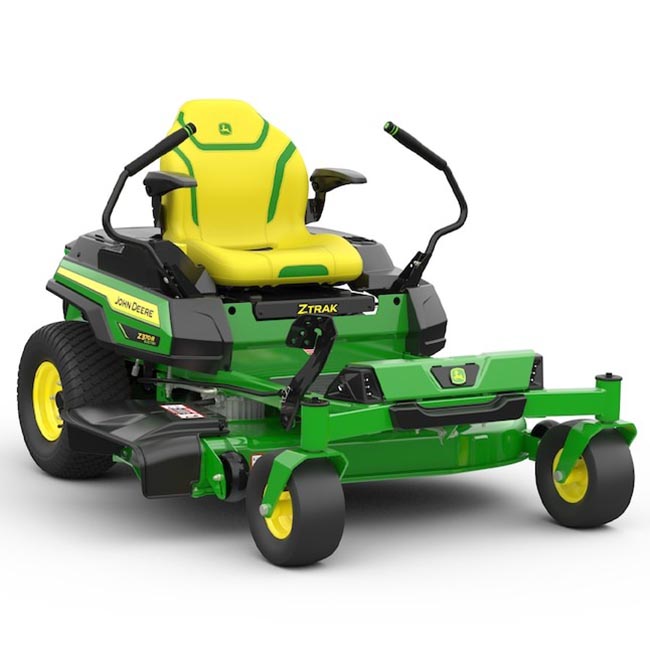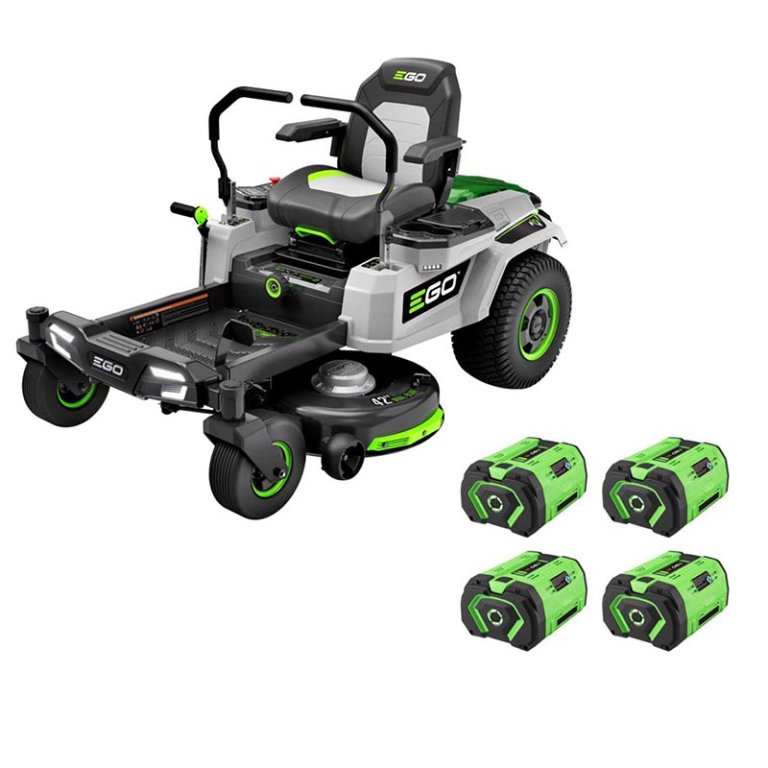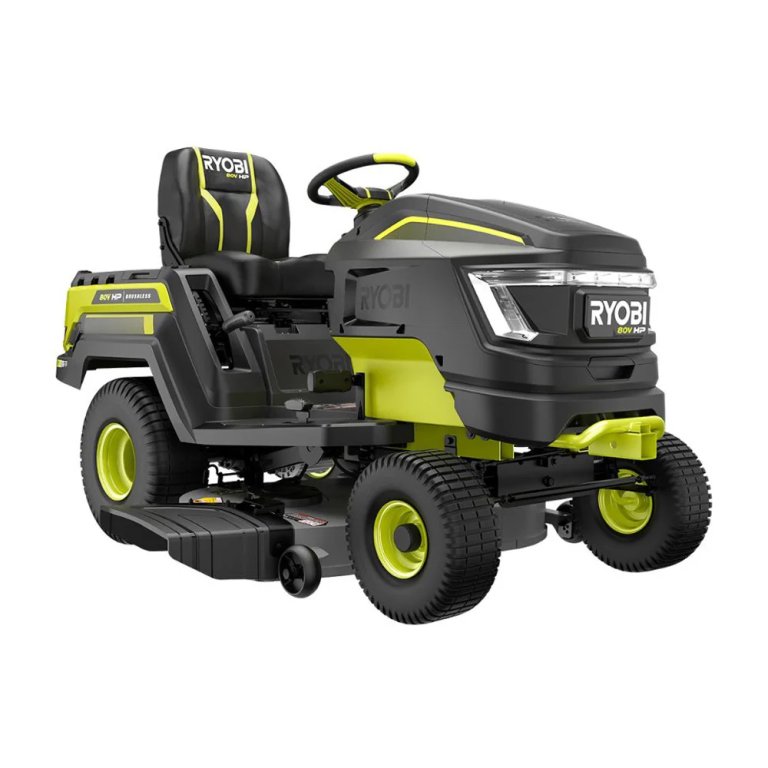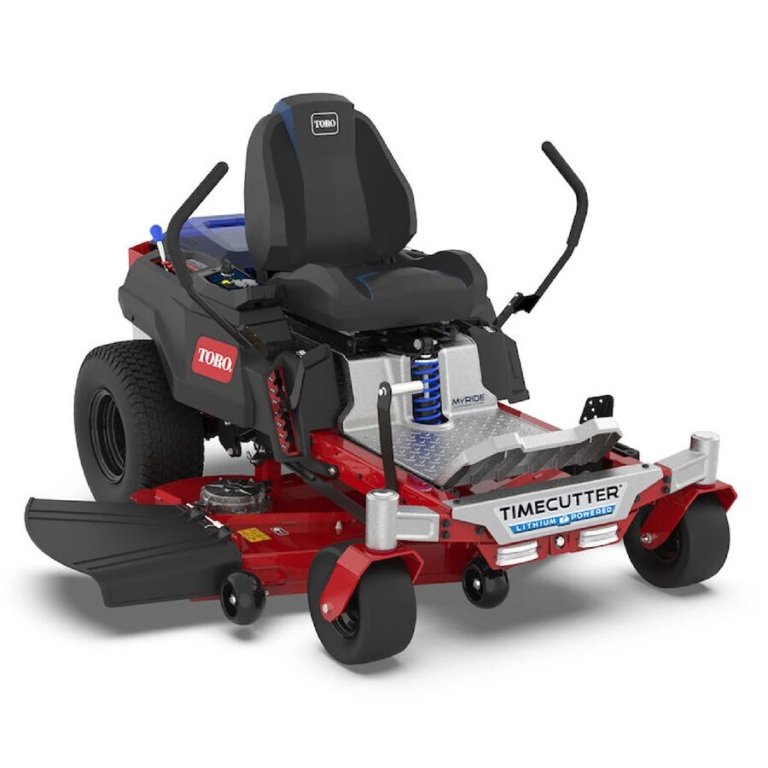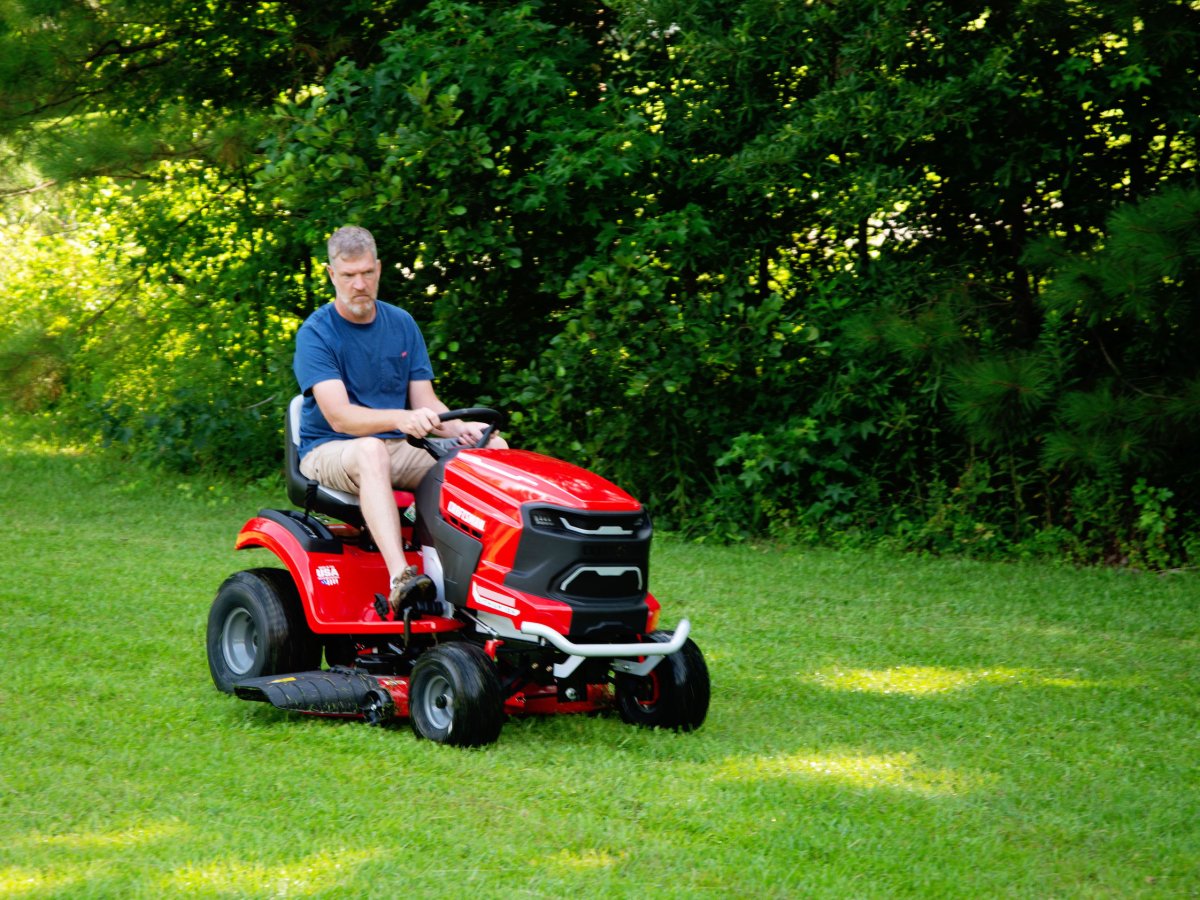
We may earn revenue from the products available on this page and participate in affiliate programs. Learn More ›
If you’re willing to spend a premium price for a battery-powered electric riding mower, you should expect quality in return. I can attest to the quality and performance of the four models in this guide because I spent 5 to 6 hours mowing 13 acres with each one. Some of their standout features include deep-cycling lithium batteries, efficient brushless motors, plush seats, and simple controls. But what distinguishes them from lesser models is their speed, smooth operation, and reliability.
While all four models performed well, my top pick is the John Deere Z370R Electric ZTrak Mower. It consistently cut up to 2 acres per charge, delivered a clean, even cut, and was comfortable to operate. Its smart charging system works with any standard 120V outlet and grounded extension cord, making recharging easy and convenient.
Earlier battery-powered riding mowers came with serious limitations in terms of range and operator comfort, but the latest batteries, motors, and software have addressed many of those shortcomings. Rechargeable battery technology has finally matured to become a competitive option for riding lawn mowers. In the review ahead, I’ll provide an overview of the best battery-powered riding lawn mowers for most lawn care needs and share the highlights from my tests.
- BEST OVERALL: John Deere Z370R Electric ZTrak Mower
↓ Jump to Review - BEST BANG FOR THE BUCK: Ego Power+ Z6 Battery-Powered Zero-Turn Riding Mower
↓ Jump to Review - BEST LAWN TRACTOR: Ryobi 80V HP Electric Lawn Tractor
↓ Jump to Review - BEST BATTERY ZERO-TURN: Toro 60V MAX TimeCutter MyRIDE Zero-Turn Mower
↓ Jump to Review
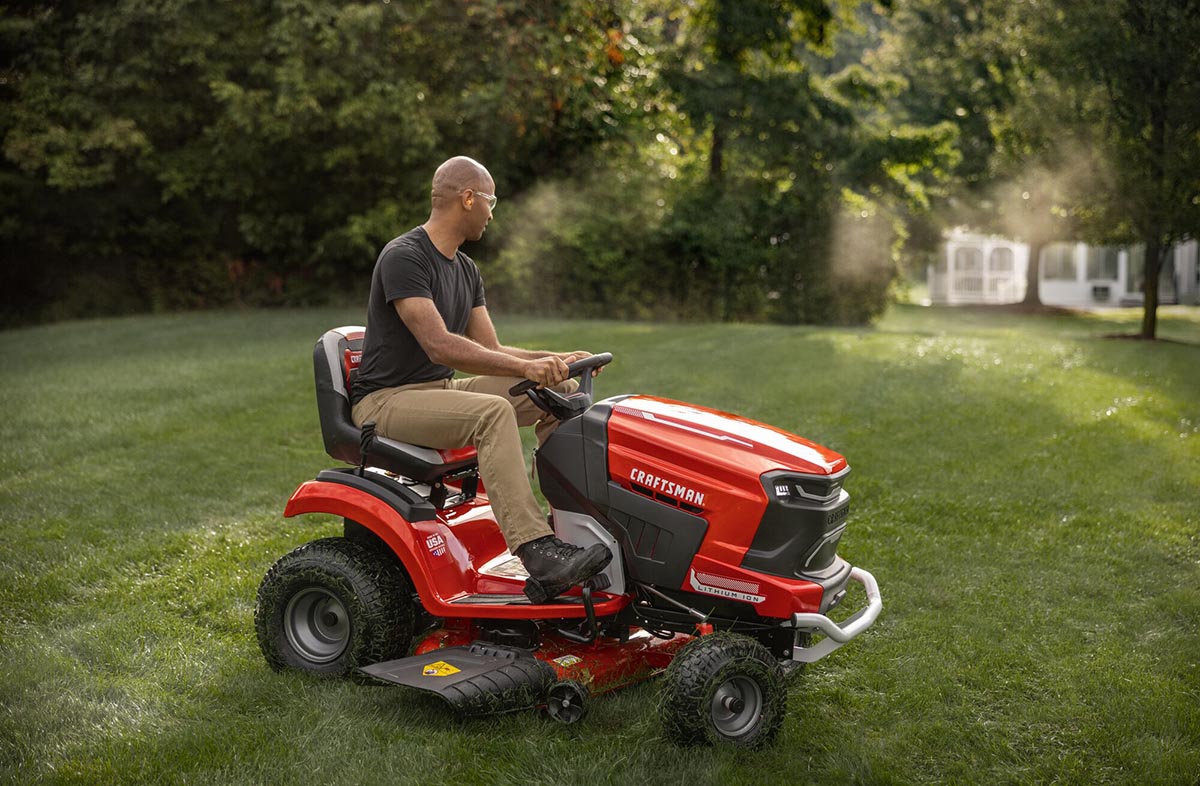
Battery-Powered Riding Lawn Mower Comparison
| Product | Battery | Deck | Top Mowing Speed |
|---|---|---|---|
| John Deere Z370R Electric ZTrak Mower | 58V lithium-ion battery, 3.56 kilowatt-hour max | 42-inch | 7 mph |
| Ego Power+ Z6 Battery-Powered Zero-Turn Riding Mower | Four 56V 10Ah, removable | 42-inch | 8 mph |
| Ryobi 80V HP Electric Lawn Tractor | Three 80V 10 Ah lithium batteries | 42-inch | 7 mph |
| Toro 60V MAX TimeCutter MyRIDE Zero-Turn Mower | Six removable 60V batteries | 54-inch | 7 mph |
Our Top Picks
This roundup includes some of the newest and best battery-powered riding lawn mowers available. Whether you’re in need of a lawn tractor or a zero-turn riding mower, you will find a clean and quiet electric option here.
Best Overall
John Deere Z370R Electric ZTrak Mower
Buy at Lowe's Buy at John DeereWhat We Like
- Mows up to 2 acres per full charge
- Built-in smart charger works with any 120V outlet
- Safe to wash with water hose
- Smooth operation and clean cutting
What We Don’t Like
- Difficult to cut grass along curved edges
- Expensive compared to gas-powered options
Product Specs
- Battery: 58V lithium-ion battery, 3.56 kilowatt-hour max
- Deck: 42-inch
- Top mowing speed: 7 mph
John Deere is a trusted name in lawn and garden equipment, so it’s no surprise that the Z370R Electric ZTrak Mower earned the top spot among the best battery-powered riding mowers. Equipped with a 58-volt lithium-ion battery, this model can mow up to 2 acres before needing a recharge. It boasts a 42-inch Accel Deep deck with adjustable cutting heights of 1.25 to 4.5 inches. It charges like a dream, featuring a built-in smart charger that connects to any standard 120-V outlet via a grounded extension cord.
I tested this mower on a 1.5-acre yard and couldn’t be more impressed with how smoothly the lap bars operated and how nicely the mower rode. Best of all, though, was the mower’s cutting ability. It evenly cut my grass, even in weedy areas. For a more demanding job, I used it to rough-cut an overgrown patch that had grass and weeds as tall as 18 inches. I raised the mower deck to its highest setting, increased the mower blade speed, and slowly went over the grass. While the battery drained much quicker than it would for a regular lawn mowing job, the mower successfully completed the task.
The John Deere Z370R was efficient, comfortable, easy to charge, and easy to operate. The only issue was mowing around curved edges. Since the mower deck only slightly protrudes past the wheels, it couldn’t reach tight spaces, requiring a string trimmer to finish the job.
Read our full review: John Deere Z370R Electric ZTrak Mower
What our tester says: “I tested this John Deere electric zero-turn mower in a large residential lot, with an acre of open grass and a half acre where the grass was broken up with structures and landscape beds. The experience was excellent. The ride was comfortable, the cut was crisp, and charging could not have been easier.” –Mark Wolfe, Product Reviews tester and writer
Get the John Deere battery-powered riding lawn mower at Lowe’s or John Deere.
Best Bang for the Buck
Ego Power+ Z6 Battery-Powered Zero-Turn Riding Mower
Buy at Lowe's Buy at Ace Hardware Buy at Mowers at JacksWhat We Like
- Shareable batteries and additional battery ports to extend runtime
- Comfortable seat with adjustable suspension and armrests included
- Cleanly cuts grass
- Features adjustable blade power
What We Don’t Like
- Controls are a little sloppy
- Tough to navigate turns in tight spaces
Product Specs
- Battery: Four 56V 10Ah, removable
- Deck: 42-inch, stamped steel
- Top mowing speed: 8 mph
As grass cutting specialists, zero-turn mowers are prized for their speed and maneuverability. The Ego Power+ Z6 battery-powered zero-turn riding lawn mower turns on a dime without tearing up the lawn and mows at speeds up to 7 mph. It’s one of the best options for mowing lots of grass in less time.
The Ego Power+ Z6 was the first battery-powered riding mower I tested, and features removable batteries. It comes equipped with four 10Ah batteries, which gives it enough power to mow almost 3 acres per charge, but has slots for two additional batteries for even greater range.
The Ego zero-turn rechargeable lawn mower stood out as one of the fastest in the test group. It lets the user adjust the blade speed up or down as the conditions warrant. This allows faster mowing through tougher conditions (to a point) by increasing mowing power as needed, or the ability to conserve battery life by reducing blade speed in easier conditions. Another subtle difference that gave the Ego zero-turn mower a competitive advantage was its deck. It delivered better airflow than the other battery riding mowers, which helped it cut taller grass more efficiently.
Although this mower features adjustable seat suspension and armrests as standard equipment, the seat cushioning and contours were not the most comfortable in the test group. Still, this was a really nice zero-turn mower with plenty of power and runtime to get the grass done quickly and make better use of the weekend.
What our tester says: “With some other battery-powered mowers I tried, I had to mow overgrown grass twice to get a perfect cut, but with the Ego Power+ zero-turn, I could bump up the blade speed and slow down the travel speed to get great results the first time.”–Mark Wolfe, Product Reviews tester and writer
Get the Ego Power+ battery-powered riding lawn mower at Lowe’s, Ace Hardware, or Mowers at Jacks.
Best Lawn Tractor
Ryobi 80V HP Electric Lawn Tractor
Buy at Ryobi Buy at The Home DepotWhat We Like
- Includes a Hyper Charger for fast battery charging
- Batteries power up to 2 acres of mowing
- Mini truck bed behind seat can hold tools
- CrossCut multiblades mow cleaner than regular mower blades
- Intuitive and easy to use
What We Don’t Like
- Thin mower blades may damage easily
- Difficult to calibrate mower deck for height control
Product Specs
- Battery: Three 80V 10 Ah lithium batteries
- Deck: 42-inches
- Top mowing speed: 7 mph
The Ryobi 80-volt (V) HP electric lawn tractor features the familiarity of a traditional lawn mower with upgraded features for enhanced comfort and performance. It includes a premium seat for rough terrain, an LCD screen to monitor battery life, towing hitches on both ends, LED headlights, and a cross-cut mowing blade system for cleaner cuts. It also features onboard storage, including a compartment under the hood and a mini storage bed behind the seat, for hauling tools or garden supplies.
Thanks to its brushless motors and trio of 10Ah batteries, the Ryobi battery-powered riding lawn mower rivals gas models, delivering power equal to a 21-horsepower gas engine. During testing, I was able to mow a little over 2 acres in about 1 hour and 15 minutes before the batteries ran out. The batteries are removable (which is optimal if one eventually needs replacing), but the included Hyper Charger also allows for on-board charging. It took about 2.5 hours for the batteries to charge from 0 to 100 percent.
This Ryobi produced a clean, even cut under regular mowing conditions. However, I encountered an issue with the deck height adjustment. It didn’t come calibrated, and even though there are 13 deck height positions, I could only get about half of them to work, limiting the cutting range to approximately 1.5 to 3 inches. That said, the mower rode well over all types of terrain and varying slopes. It also pulled my dump cart smoothly.
Read our full review: Ryobi 80V HP Electric Lawn Tractor
Get the Ryobi battery-powered riding lawn mower at Ryobi or The Home Depot.
Best Battery Zero-Turn
Toro 60V MAX TimeCutter MyRIDE Zero-Turn Mower
Buy at ToroWhat We Like
- Mows up to 2.3 acres per battery charge
- Comfortable and bump-free operation
- Features a heavy-duty steel deck
- Has LED headlights
What We Don’t Like
- Must remove the batteries to recharge
- Large, 54-inch deck won’t fit through narrow spaces
- More expensive than other models
Product Specs
- Battery: Six removable 60V batteries
- Deck: 54-inch
- Top mowing speed: 7 mph
Those looking for a fast and comfortable electric zero-turn mower won’t regret opting for this Toro TimeCutter model. It features the MyRide suspension system that isolates the cockpit from the mower system, allowing for a bump- and vibration-free ride. Paired with a deep gaming-style seat, this mower is a real backsaver on rough or bumpy terrain.
Of course, comfort means little if the mower isn’t able to cut cleanly. Fortunately, this mower delivers. The Toro is equipped with a 54-inch deck, two blade speeds (high and low), and an adjustable deck height of 1.5 to 4.5 inches. On my 1.5-acre lawn, I used the high blade speed, set the deck to 2.25 inches, and mowed at about 3.5 mph. The result was a clean, even cut with a well-distributed layer of clippings.
I also performed a field cut test, mowing over weeds and grass that had grown 12 to 18 inches in height. I used the highest deck setting and crept over the weeds at about 2 mph. The cut was reasonably clean, and the clippings were only slightly clumpy.
The Toro is powered by six 60V batteries, which lasted me about 2.25 acres before needing a recharge. Recharging the batteries was a bit of a pain, as each battery had to be removed and placed on the charger. The batteries also didn’t charge evenly—four of them charged in four hours, while the other two needed an additional 90 minutes to achieve a full charge.
Read our full review: Toro 60V MAX TimeCutter MyRIDE Zero-Turn Mower
Get the Toro battery-powered riding lawn mower at Toro.
Jump to Our Top Picks
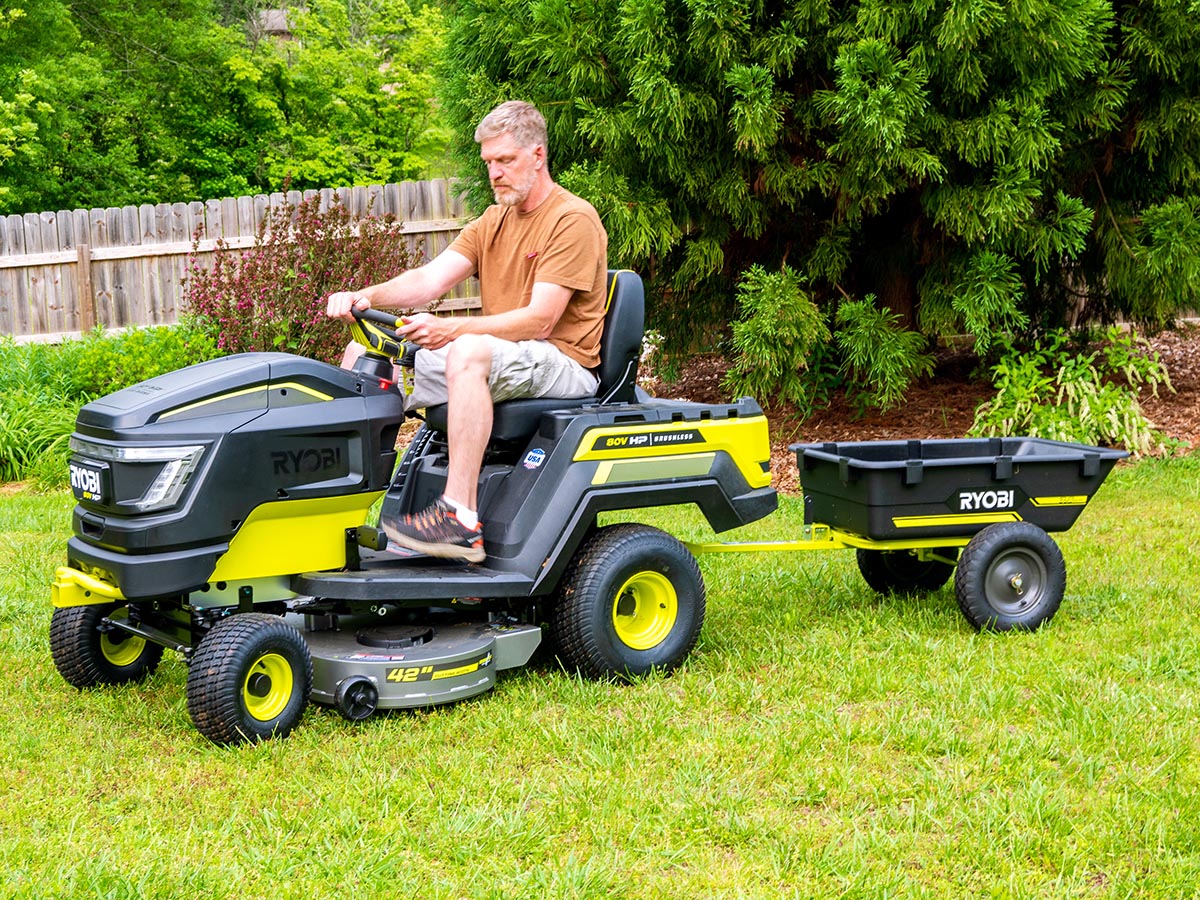
How We Tested the Best Battery-Powered Riding Lawn Mowers
| Testing Stats | |
| Products tested | 7 |
| Hours/Weeks/Time spent testing | 4 months |
| Tests performed | 3 |
| Price range | $5,000 to $7,000 |
In this guide, we wanted to showcase the most up-to-date battery-powered riding mowers available. We researched offerings and tested seven battery-powered riding mowers before finally settling on the four models showcased here. Each of the models we chose was newly released in 2021 or later. We limited our selections to riding lawn mowers that are powered by lithium-ion batteries because of their longer battery life, higher efficiency, deeper cycling ability, and rapid discharge capability compared to older sealed lead acid (SLA) batteries. For a mower to be considered, the manufacturer’s specifications had to show that it could cut at least one acre of grass per charge in a half hour or less.
We spent 4 months putting each mowing machine through a series of tests on a 2-acre property, mowing a combined total of more than 52 acres in the process. Starting with a full charge and grass at the typical height before mowing, we cut as much of the grass as possible until the battery ran out and recorded the total area mowed and runtime per charge. Again with the grass at normal height, we tested the maximum mowing speed on a 1-acre obstacle-free portion of the lot. Finally, we let the grass grow out for 3 weeks and mowed again to find out how extra-long grass would affect battery life and cut quality. Throughout testing, we recorded observations regarding comfort, handling, control layout, noise, and cut quality.
What to Consider When Choosing a Battery-Powered Riding Lawn Mower
When it comes to battery-powered riding lawn mowers, buyers have many of the same options at their disposal as those shopping for gas mowers, including power sources, style, size, and more. To get the best results, consider what’s most appropriate for your yard and work habits.
Battery
Older and less expensive pieces of battery-powered lawn equipment use SLA batteries, very much like those used in old-style golf carts. They are cheap and reliable, but they are quite heavy and typically have a shorter lifespan than lithium-based batteries.
Lithium-ion and lithium-iron batteries are the best power sources for electric riding lawn mowers at this time. Compared to SLA batteries, lithium-based batteries weigh less, run longer per charge, discharge more energy faster, and have a longer lifespan. The upfront price of the battery is higher, but the cost is lower in the long run.
When it comes to battery sizes, don’t let the ratings be a source of confusion. A watt-hour rating is an apples-to-apples metric that can be used to compare batteries. To calculate a battery’s watt-hour rating, multiply the battery’s voltage by its Ah. For instance, a 56V 60Ah battery has 3,360 watt hours, while an 80V 10Ah battery has 800 watt hours. When a mower uses multiple batteries, sum the watt hours for all batteries.
Riding vs. Zero-Turn
For many shoppers, a “riding mower” means either a lawn tractor with its engine in the front or a compact rear-engine riding mower. Zero-turn riding mowers are quite different, in part because they’re designed with different goals in mind, and in part because they usually cost significantly more money. Which one a particular shopper should buy depends on several factors, including their lawn’s acreage, landscape layout, usage patterns, and personal preferences.
Traditional riding mowers make sense for a wide range of landscapes, especially those between half and 2 acres. They mow at a moderate pace, store in a moderate space, and can be used for towing and hauling in addition to mowing. The design of the machine is generally well balanced for use on moderately sloped terrain, so they are the better choice in hilly areas.
Zero-turn riding mowers are grass-mowing specialists. They work fast and require more storage space. These machines are ill-equipped for working on slopes due to their lightweight build, and narrow passages can be problematic because of the deck layout. Although zero-turn mowers may come equipped with a rear hitch, their towing weight capacity is generally quite limited. These machines are best used on large, relatively flat yards.
Deck Size and Discharge
Most battery-powered riding mowers are equipped with decks in the 38- to 54-inch range. Deck size, along with mowing speed, is one of the most important contributors to fast mowing times. With battery mowers, deck size (along with blade length and number of blades) is inversely correlated with battery life. Larger decks, longer blades, and more blades require more power. There are numerous mowers with 42-inch decks at similar price points but few larger decks because of the proportional increase in battery consumption and the associated increase in cost that occur by increasing deck size.
Like other mowers, battery-powered riding lawn mowers can be configured for side discharge, mulching, or bagging the clippings. Side discharge is the standard configuration, but mulch kits and bagging kits are available from most manufacturers. Mulching and bagging may decrease runtime per charge.
Additional Features
Battery lawn equipment brands offer many of the same operator comforts available on gas-powered mowers, such as premium high-back seats and cup holders to go along with quiet and exhaust-free operation. And where gas mowers often come equipped with some type of fuel gauge, electric riding mowers also include a “fuel gauge” in the form of a digital charge indicator on the control panel. We preferred those with a numerical readout of the charge percentage, but some use a bar graph indicator instead.
Other features to consider include the onboard charging system, deck-height adjustment system, and LED headlights. The models we tested all included 10-foot charging cords or pod chargers, but we also had to take into account the placement of the charging port when parking the mower. Additionally, we had to determine whether it was necessary to pull in, back in, or approach the outlet on the right or left side of the mower.
The deck height levers were comparable in operation, but we preferred those positioned on the right side (the discharge side) of the mower. The left side (the edging side) of the mower comes closer to fences, shrubs, and other obstructions that risk entanglement. For zero-turn mowers, consider those equipped with a foot-operated deck lift lever to reduce strain and stress.
FAQs
If you have a few lingering questions about battery-powered riding lawn mowers, especially when considering a gas versus electric lawn mower, rest assured that you are not alone. We’ve answered some of the most common questions in the segment below.
Battery-operated riding lawn mowers offer a quiet, zero-emissions alternative for routine lawn care. They eliminate the need for gas and oil, turn on at the touch of a button, and do a great job cutting grass. When used for lawn maintenance, they’re useful; however, they’re not designed for rough cutting or field mowing. For heavy-duty field mowing, gas mowers are a still better choice at this time.
Electric mowers are built to last as long as their gas-powered counterparts, which typically means 10 years or more. The electric motors that power the wheels and blades could last even longer, so the battery is the main limiting factor. Following the manufacturer’s instructions for battery maintenance, repair, and storage is the best way to get the most out of your mower in the long run.
Riding mowers are ideal for large lawns between a half and 2 acres. If the terrain is flat to slightly rolling, a zero-turn riding mower would be best, while a lawn tractor would be better for hilly terrain.
Brushed and brushless motors differ in how they transfer electrical current. Brushed motors are typically less expensive than brushless models, but they tend to be less efficient and have a shorter lifespan.
A lithium-ion cordless lawn mower battery typically lasts between 3 and 5 years. Its lifespan can be affected by climate and storage conditions, as extreme temperatures may cause premature wear. Maintenance habits and frequency of use also play a role in overall battery longevity.
Yes, it’s possible to overcharge an electric lawn mower battery, but this depends on the type of charger used. Many of today’s smart chargers stop charging once the battery is full, helping to prevent overheating.
It’s generally not a good idea to leave your electric or robot lawn mower battery on the charger all the time. While many modern smart chargers prevent overcharging, it’s still best to unplug the charger once the battery is fully charged.
Store your electric riding lawn mower in a cool, dry place, preferably in an area without extreme temperature fluctuations. Before storing, clean the mower and remove the battery. (The battery should also be stored in a cool, dry location.) Refer to the manufacturer’s instructions for specific storage guidelines applicable to your model.
Why Trust Bob Vila
Bob Vila has been America’s Handyman since 1979. As the host of beloved and groundbreaking TV series including “This Old House” and “Bob Vila’s Home Again,” he popularized and became synonymous with “do-it-yourself” home improvement.
Over the course of his decades-long career, Bob Vila has helped millions of people build, renovate, repair, and live better each day—a tradition that continues today with expert yet accessible home advice. The Bob Vila team distills need-to-know information into project tutorials, maintenance guides, tool 101s, and more. These home and garden experts then thoroughly research, vet, and recommend products that support homeowners, renters, DIYers, and professionals in their to-do lists.
Meet the Tester
Mark Wolfe is a writer and product tester with an extensive background in the nursery and landscaping industry. For more than 20 years he mowed, edged, planted, pruned, cultivated, irrigated, and renovated beautiful landscapes. Now he tests and writes reviews about the latest outdoor power equipment, hand tools, lawn care products, and other outdoor-living goods.
